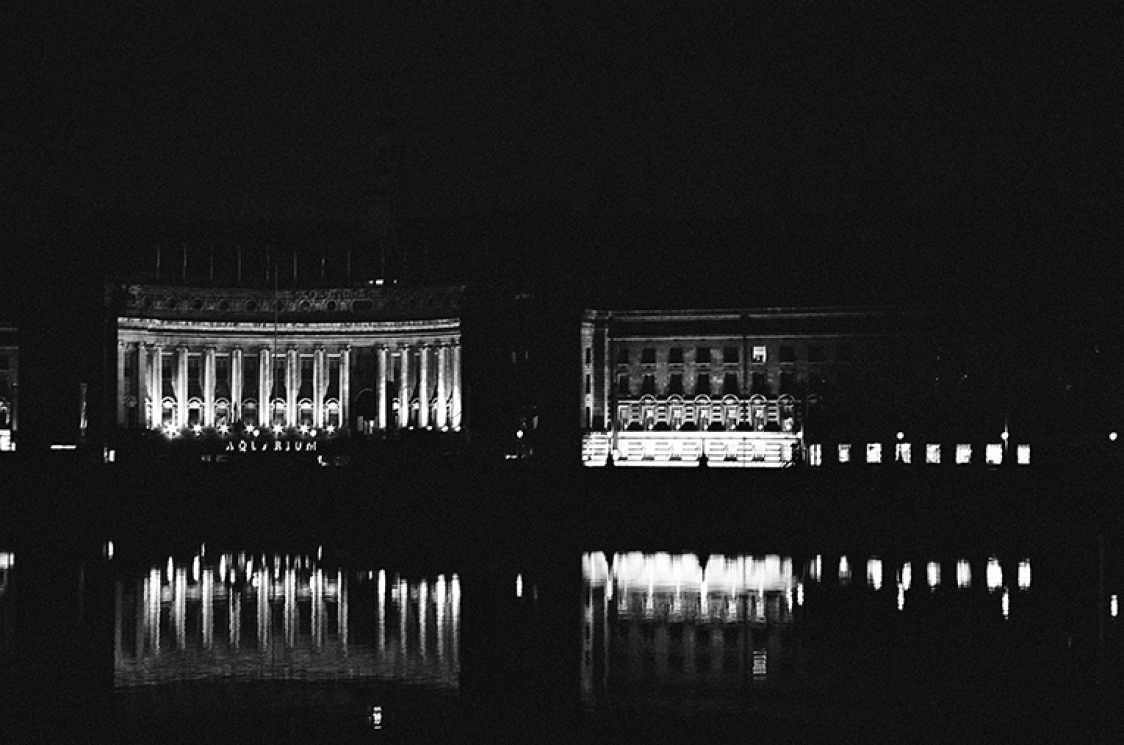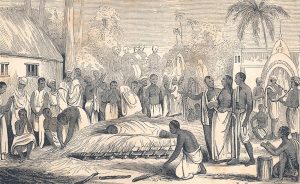BETWEEN THE DIURNAL AND NOCTURNAL
By ISHMAEL ANNOBIL
September 2006 has been a joke; there are no fallen leaves anywhere to be seen, and not even a hint of frost on parked cars. The night is constantly young and warm, my gang and I are duly under-wrapped and hale – I am happy they have chosen to come along to paint with light, too.
We are a tight crew of three: Abiy Mamo, an Ethiopian photographer, William Olivier, a South African filmmaker, and, moi, a Ghanaian doing both disciplines and with a special thing for night photography. I am the pathfinder tonight. Something ethereal fills the space around us as we cut swathes in the bright night with our ambition; the ambition being a fusion of styles and perceptions for one or two nights only.
Abiy is more of the formalist, William is by all accounts an Avant Gardist like me, but his experiments have been only in cine and video, and I am the documentary and art photographer with a burning to turn the mundane into iconography. Our medium today is 35m film, 200 and 400ASA. Our digital contraptions have been forsaken for the sake of ‘genuine’ photogeny. To be precise, we are only equipped with fully mechanical and semi automatic SLRs, average speed film and two tripods. But one of the tripods is so cheap I reckon I might batter it on the kerb then appease the Thames with its ‘bones’. However, it has a good quick release plate, so it survives my umbrage –I curse the dubious eBayer instead.
I suspect we look splendid or something like that because every person we meet, from chicken & chips chefs to revellers, wants to be in our shot all of a sudden. Ditto the fox that forages at our feet on our way out. Only, it choses to defy Abiy, just when he decides to call its bluff, and sails off on those mercurial feet, leaving only half a blur to remember it by. We make up for it by responding to the alacrity at a Camden takeaway, feting a cheeky Iranian party with our lenses. Their obvious leader, Hussein, a boxer and wrestler, lands an instant part in our forthcoming film about boxing.
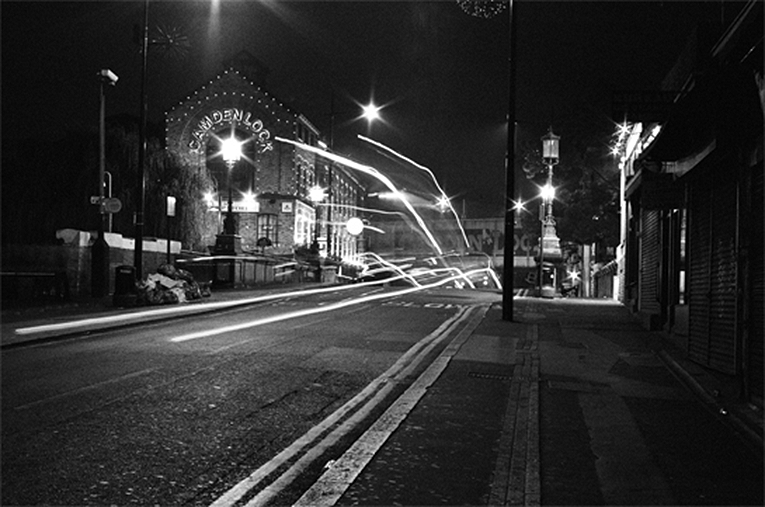
We wave bye-bye and take to the dancehall of night, where lights befuddle the eye and turn buildings great and small into haunting canvasses on which light plays quaint tricks. We slide down the side of Mornington Crescent Tube, watched jealously from the distance by the black stone cougars of Greater London House. The branches of the trees opposite that great white building lean out into quivering silhouettes, evoking old-time real estate brochures. But we refuse to shoot pretty.
We want mystique; the type that night releases to mark the parting of diurnal and nocturnal souls. It may be in the way shadows elongate, or the way the asphalt street holds and reflects light like a gemstone; it may even be the keen but soothed timbre of sound, or the wispy wind that strokes your face like the proboscis of a monarch butterfly, but whatever it is, it makes night very complex to capture on film. In hindsight, film is the apt medium for this quest, as it is itself an epitome of night. It captures latent image.
But we must first shoot the Jesus statue of St Aloysius Church, Eversholt Street, Camden. I plan to get something akin to the Ascension of Christ on that one. We shoot our way to it. The street has nothing left of its heavy daytime human and vehicular traffic, and its usually non-salubrious aspect now has a sweet patina to it. It lies limply before us like a private pathway, and its shop windows have become light boxes into which one could peer shamelessly.
I pitch my tripod in front a hairdresser’s and capture its elephant mascot with a gloat, as no one else sees what the hell I see in it. For my part, I am reclaiming something from the dark, and I know that the faux ivory elephant’s overwrought surface should reflect light interestingly. It is cheesy as hell, but also as comforting as fish and chips. Actually, it glows on the lens. I take my shot without hesitation.
Before moving on, I remember I have been contemplating a wide shot of the whole shopping mall all along. The trees fringing it are leaning out in concert to shelter the street below. It seems unreal; as though cultured by royal command. The subdued lights and shadows are not easy to ignore either, so I step back, take a reading, close down my aperture, and take one long sure shot (first shot is always best). I know I have a magical scene on film, but my own gloating is beginning to get on my own nerves, which makes me suspect that my partners may be tipping over with irritability by now, so I pack up rapidly and march purposefully towards St Aloysius Church.
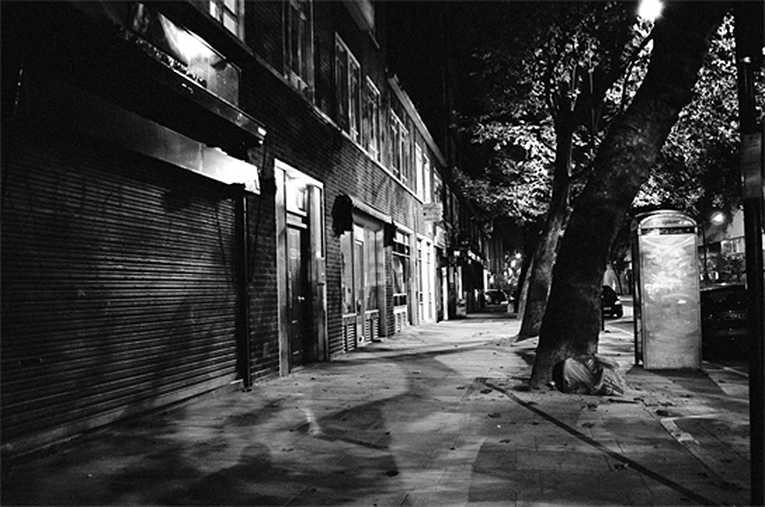
The Ascension proves to be my most difficult shot of the night because I have to be literally supine to get the right effect. The idea is to get it to fall back and levitate. I am barely a meter from the wall, therefore, negotiating something like a 15-degree angle. I can barely see the viewfinder display against the pitch black of the sky, and though I can normally meter easily for the brightest part of the icon, I cannot get a good account of the periphery for contrast. I employ my reading spectacles, but they, too, play havoc with the dioptre of the viewfinder. After a futile, tear-inducing metering session, I settle for a very small aperture, an instinctive ‘B’ mode countdown and luck. Strangely, I take only two shots, the second being less ambitious but close to the ideal.
It turns out Abiy has just waltzed through that same shot at a gentler angle. He’s been all-smiles since we left home. He has captured some cinematic shots of Wil prostrating in the street to compose a shot of me next to a door, posing as a locked-out person waiting for daybreak. One gets the sense that Abiy is knowingly documenting the first steps of a prodigious SLR acolyte. But I know he smarts from scoffing at my elephant shot: “I can’t see anything in it,” I remember him saying, while taking a casual shot at it. All the same, I sense he is getting some great shots because he keeps muttering our “O, men” mantra. Deep inside I am sceptical about the Aloysius shots, so I vow quietly to go back in the near future to surmount it (the one above is the less ambitious one).
Further down the road, I find the mother of all photographic challenges: a black pub with benches outside. The subtle street lighting makes things shimmer somewhat, despite the inherent difficulties it presents. In any case, I know I will be metering for the light, so I warm up. My chance to bury any self-doubt. I frame tight, making sure to catch some of the street and its mysterious reflection just to enhance the idea of desolation. I take only one shot, trusting profoundly in my instincts. It is a frisson thing. You know when you have it.
For his part, William spots an emergency exit on the side of the pub. It descends from a first floor through a fringe of creepers, maybe wisteria, and I know the nondescript nature of this dark corner is what appeals to the Avant Gardist in him, so I sit on a dewy bench and wait for him to count the seconds in ‘B’ mode. He too takes a single shot. Meanwhile Abiy shoots me reposed on my dewy bench.
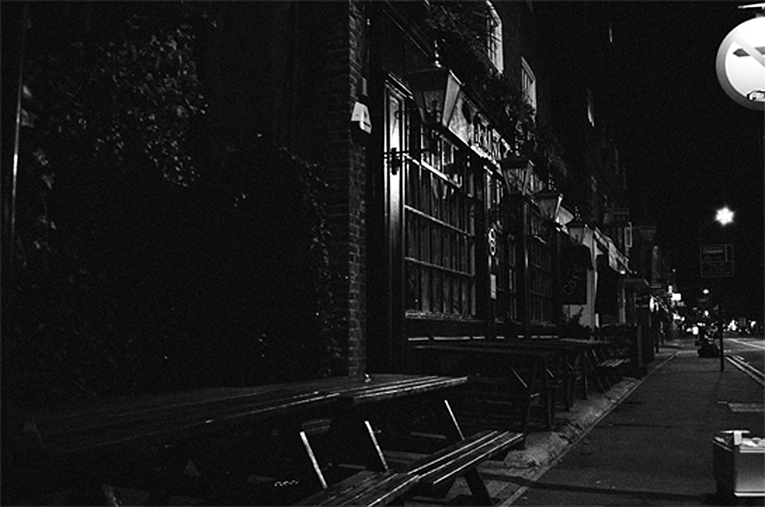
We trudge on towards the scene of the July 7 bus bombing. We cross the busy Euston Road and come rather symbolically to St Pancras Church, which offers a timely sense of ethereality, what with the homeless sheltering in its generous portico. We pass it quietly, and I spot a marble celestial head glowing in its grounds like a pilgrims’ milestone, making light of the bars of iron fence between us. The skill of the sculptor overwhelms me with its scholarly restraint. One suspects it is a bas-relief, especially because it emerges from a wide rectangular slab that extends beyond the curvature of three-dimensionality. I hanker to see the backside to confirm my theory, but, of course, the Victorian metal fence restricts such vulgar enquiry. Nonetheless, I set up my camera between two of its bars and pull the glowing head into frame. On second thoughts I zoom out slightly to surround it amply with the darkness. I select a big aperture just to isolate it further, anticipating that the soft lights in the background will blur into magical whorls. “This will be pivotal,” I say to the guys. I take my two shots (without disrespect to the first) and we sail on quietly.
I feel rather nice and free all of a sudden; I say a big hello to two middle-aged Caribbean commuters at a bus stop. They respond with warmth. I hum something to myself for a while then we all start chattering like children about one thing or the other. We all acknowledge we are having a good shoot and want more and more of the night. The dew forces the temperature to drop slightly now, but we are beyond influencing.
However, as we walk this street that was desecrated by phantom religiosity, I wonder about the state and future of our world. I recall what optimism used to feel like during my youth in Ghana, when even the cold-war rhetoric enhanced hope and created an ironic sense of wonderment about far-flung cultures – curiosity. I also remember how heads of state actually looked like heads of state; charismatic, intelligent and eloquent, whatever their dogmas – people like Kwame Nkrumah, Leopold Senghor, Ted Heath, Willy Brandt and Mao Tse Tung. At least each had a genuine vision and an ideology to trade, and also a good feel for détente. I guess I miss the scholarship and the debate. All we have today are pixies and pretenders, all given to inane rants and a passion to make a virtue of double-talk, vengeance and killing – dimwits.
They are everywhere around us, from East to West, North to South, and the Balkans are presently showing a particular talent for producing them by the truck-load, all baby kissing fascists with insatiable commercial interests in their own countries' resources. Then there are the Islamic ones, like the ones that bloodied this street, who think a rant and a bang will disguise or even elevate their personal sins. The simple irony (and blashemy) of expecting God to reward them with a harem of virgins in paradise is lost on them.
Sadly, this proves my age-long suspicion that sexual frustration lies behind all fascists, be they fanatical Christians, fanatical Moslems or plain stupid xenophobes. Alas, with each of these pinheads, the disease often manifests as a call from the heavens, even though it causes mayhem, undermines natural sovereignty and, worse still, misrepresents God.
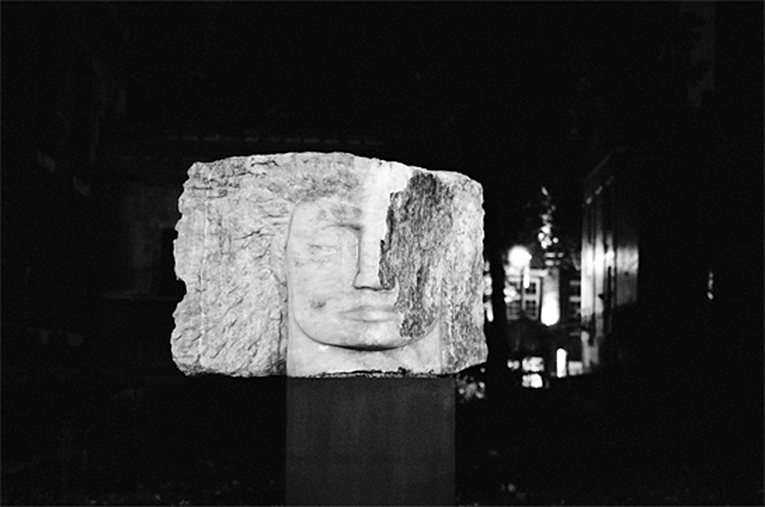
Well, at least I know Ghandi’s statue watches over this very street from his central plinth at Russell Square Gardens. For this night at least Ghandi is the guardian spirit of all victims of terrorism, I muse. He has to be – he was killed by fanatics. My optimism restored, I rattle along into Bloomsbury, a place that has always held a special place in my heart for its little parks and pubs and sheer historical ambience. There is the literary history, too, of course.
After seven minutes of scanning every nook and cranny for worthy material, we suddenly come under the spell of the mighty Hotel Russell. A half hidden moon seems to coax the massive building to rise to it, and its roof seems to be halfway up there already. I encourage my party to get this spectacle on film, but they are already limbering up to the task; which means that the two tripods are taken.
But then I surmise that, as we are shooting upwards, I could do a handheld by resting the back of the camera on my face. I meter for the moon glow for extra speed then fire, knowing that my shot will be subtler than subtle, on account of the faster speed – my kind of shot, anyway. And yet, I secretly rue not having a tripod to bracket my shots with. The excitement about shooting this moon-chaser of a building creates a frenzy suffused with the clatter of tripods, making us seem like a Dad’s Army in the face of a German tank. Just as we decide to let go, a cloud wipes away the moon.
We lunge deeper into Bloomsbury, full of cheer, knowing fully well that the Hotel Russel is a hard act to follow - henceforth we can only expect simpler subject matter. Nevertheless, I like abstraction and the folksy titbits to be gleaned along the little streets just off Southampton Row. Not to be outdone, Southampton Row presents me with a quaint black phone booth. Abiy ribs me for my fascination and I rib him back quietly for failing to see the anachronism of a black phone box in a land of red municipal icons. I savour and show off my shot before taking it, only to realise that I have just switched to a colour film. This gives me mixed feelings about the shot, though I accept that colour film is the thing, if this anachronism is to be made obvious.
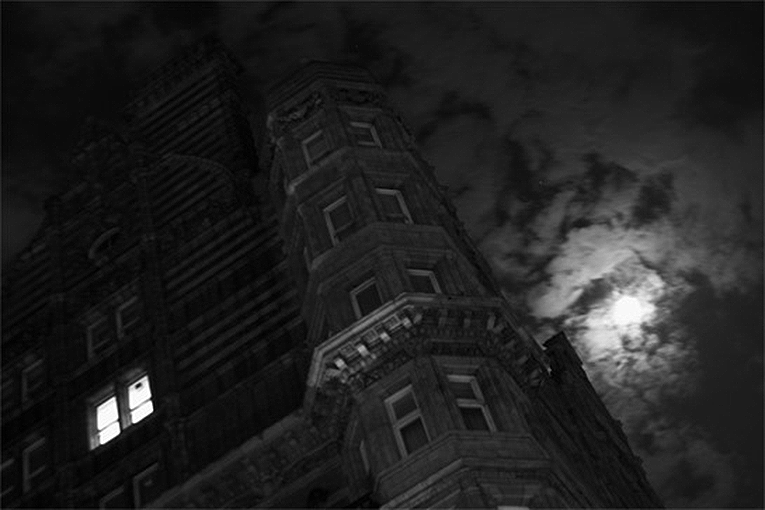
And as if to justify the use of colour further, I train my camera on the Cochrane Theatre at St Martin’s College. The clash of street lamps and traffic lights renders the Cochrane’s ‘advertorial’ lighting in sharp relief. And the street between it and my camera offers a perfect opportunity to catch swishing taillights of cars. As I fire away, I hear one of the guys expressing an urgent need “to piss”.
We presently wind our way round to a back street in search of an imaginary urinal, the type that raises your blood pressure even if you are getting away with the crime. Our desperate colleague (who shall remain nameless) forges ahead fervently and positions himself unwittingly under a police CCTV for his ritual. Desperate as he is, he fails to see the damned thing or hear our whispered warnings. We stay a cautious distance from him, in case he is caught and we have to dissociate. None the wiser, he re-emerges from big brother’s eye with a triumphant smile on his face. We break the news of his faux pas to him. His eyes take on a doglike look of fear and contrition, and we evacuate Bloomsbury in haste, braced up for police sirens.
Photos:
1. South Bank, Ishmael Annobil
2. Camden Lock, Abiy Mamo Azene
3. Eversholt Street, Ishmael Annobil
4. Black Pub, Ishmael Annobil
5. St Pancras Icon, Ishmael Annobil
6. Hotel Russel and Moon, William Olivier


